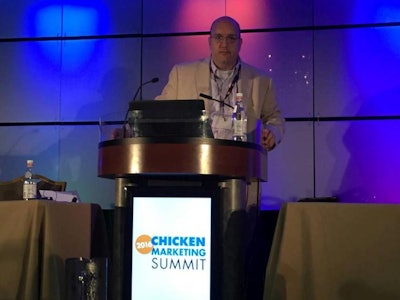
In order to meet consumer expectations, the poultry industry must step up its transparency and provide consumers what they want. This was a common theme in presentations at the 2016 Chicken Marketing Summit, which focused on consumers’ changing demands, calls for cleaner labels and fewer ingredients, and more information about where and how food is produced.
Currently, U.S. chicken consumption sits at a 3-year high in 2016 with nine in 10 (92 percent) consumers saying they purchase chicken regularly, surpassing levels in 2014 and 2015, according to the results of a new survey, commissioned by the National Chicken Council (NCC), which released its findings at the Chicken Marketing Summit on Monday, July 11.
The survey results also echoed consumers' desires for producers to remove antibiotics from poultry production and be more transparent about their products. When asked if various claims would increase, decrease or have no impact on their likelihood to purchase their favorite chicken products, consumers were most interested in knowing that "no antibiotics ever" were used in production of their food. As seen in 2015's survey, consumers also want to know where their food comes from; consumers reported having the greatest interest in poultry products boasting claims like "locally raised" or indicating the country of origin on the label.
Poultry industry forecast
According to Richard Kottmeyer, vice president of agriculture and food for Luxoft, told the audience that the poultry industry’s success in 2016 and going forward will ultimately depend on how well the industry meets U.S. consumer demands, and emerging food trends.
Due to the move to antibiotic-free poultry for much of the industry after calls from consumers, more management is needed with more human oversight, requiring more steps in the production process. Kottmeyer said that as the industry moves to meet the demand for cleaner labels, it will need to take out the variability and variation in production in order to avoid a food safety issue as a result of the lack of antibiotics use.
In terms of changing consumer trends, Kottmeyer said that the trend in increasing vegetable consumption could sit well for poultry producers because poultry is an easier protein as a complement to a wider variety of vegetables. He also said that consumers are judging a food’s healthiness by how they feel after they eat it, and since consumption of poultry is relatively easier than red meats, this, too, could benefit the poultry industry.

Richard Kottmeyer, vice president of agriculture and food, Luxoft | Alyssa Conway
Another area of growth highlighted by speakers Chris DuBois and Elizabeth Ehrhardt of IRI was the fresh prepared retail category, which is the fastest growing area of the perimeter. According to insights presented by DuBois and Ehrhardt, leaders in fresh prepared foods can better compete with restaurants and in the specialty channel, create stronger emotional linkages with customers, and gain bargaining power with suppliers. They pointed to huge potential for chicken in fresh prepared, especially for those suppliers and retailers who are able to tailor the products and shopping experience to the specific retailer and customer.
Importance of listening to consumers
NCC research also showed the importance of consumer perceptions about their foods. According to research presented on July 11, when consumers think that chickens are treated poorly, they believe this has a direct impact on the safety and quality of the meat they buy. Gary Corbett, CEO of Fair Oaks Farms, echoed the importance of showing people that agriculture and animal welfare are compatible. He shared Fair Oaks experience of opening up its dairy farm operations for tours, embracing transparency and educating consumers about the truths of modern agriculture production.
NCC’s research also found that 78 percent of consumers surveyed believe that their chickens are genetically modified to grow bigger/faster, 77 percent believe there are added hormones or steroids present in most chickens, and 73 percent believe there are antibiotics present in most chicken meat. As a result of consumer misperceptions and changing consumer demands, food companies are increasingly changing their policies on purchasing chicken.
Ernie Meier, director of quality for McDonald’s told the audience that McDonald’s is well on its way to delivering on its commitment to allow no antibiotics important to human medicine in its chicken by 2017. The commitment made by the company in 2014 to respond to consumer demands allows the use of one class of antibiotics, ionophores, used to control coccidiosis in poultry flocks.

Ernie Meier, director of quality for McDonald's | Alyssa Conway
A number of other executives also spoke on their commitments regarding antibiotics use in chicken, including Chris Chang of Raising Cane’s, Dean Bradley of Buffalo Wild Wings, Mike Ledford of Chick-fil-A and Stefan Oellinger of Fresh Direct. It was clear that companies’ commitments on antibiotics were driven by their unique customers.
Driven by strong feedback from consumer surveys, Chick-fil-A announced in 2014 that it would commit to a 100 percent “raised without antibiotics” standard for its chicken.
In contrast, Bradley said his customer differs in that they want “warm wings, cold beer and watch their game on TV,” so they have not heard much feedback from consumers demanding huge antibiotics policy change.
Oellinger said Fresh Direct offers a variety of chickens, from regular to organic to antibiotic-free to slow-growth chicken to appeal to its wide variety of consumers, but his best consumers are demanding to know how their chicken is raised, where it comes from and how it is processed.
Alternative types of chicken
Because chicken consumers vary greatly in their preferences and companies vary in their ability to produce different types of chicken, speakers also gave their experiences with alternatives in chicken production.
Not all producers can afford or choose to go totally antibiotic-free and different retail and fast-food customers are looking to purchase different products, so Dr. Karin Hoelzer, DVM, Ph.D., officer in health programs, Pew Charitable Trust, explained an alternative to antibiotic-free poultry production: Certified Responsible Antibiotic Use standard.
According to Hoelzer, responsible antibiotics use is an effective alternative to a no antibiotics policy because it is less expensive to produce chickens in this way than fully converting to no antibiotics, making it a more viable option for a greater segment of the industry. The policy allows for antibiotics, both veterinary and those medically important to humans, to be used for treatment and prevention purposes but only under veterinary oversight and only if really necessary for the health of the bird.
Further, she said, the need to treat sick birds will always exist in any operation. But because a responsible use antibiotics policy still allows for sick birds to be treated as prescribed by a veterinarian, there is no need for a secondary market to divert birds that are treated, as is required for those in a no antibiotics ever system.
Claude Toudic of Hubbard France also discussed the slow-growing broilers of the UK, France and the Netherlands, in light of recent interest expressed by Whole Foods and others in demand for these chickens in the U.S. market. He pointed to research from Europe showing these slow-growing breeds can have better livability, gait scores and reduced carcass deformities than traditional breeds.
The Chicken Marketing Summit, presented by the National Chicken Council and WATT Global Media, was held July 10-12, 2016, at the Omni Hilton Head Oceanfront Resort in Hilton Head, South Carolina. The 2017 Chicken Marketing Summit will be hosted July 16-18, 2017, at the Historic Grove Park Inn in Asheville, North Carolina.
















